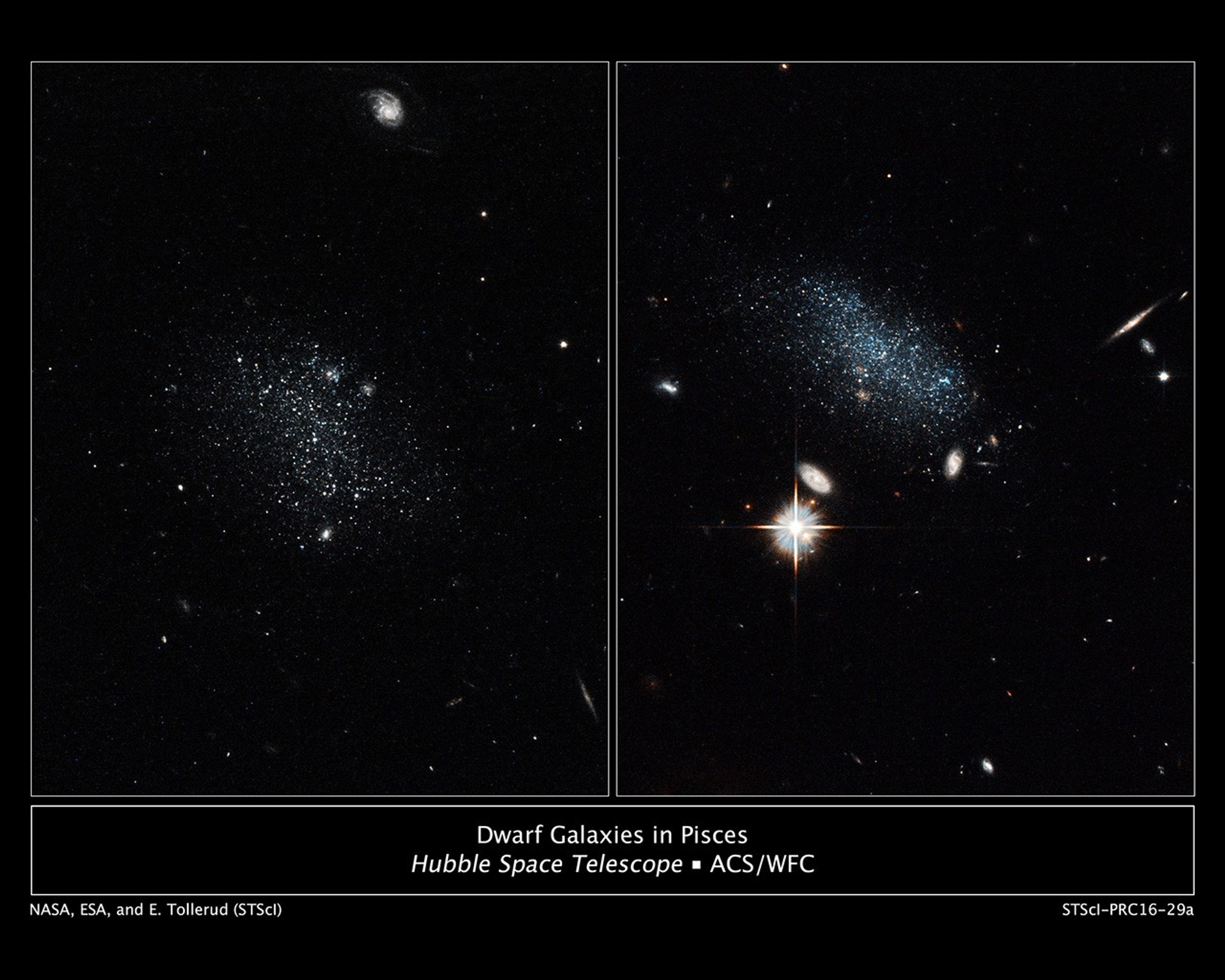1 min read
Dwarf Galaxies in Pisces

NASA's Hubble Space Telescope has captured the glow of new stars in these small, ancient galaxies. Pisces A is on the left and Pisces B is on the right.
Astronomers estimate that less than 100 million years ago both galaxies doubled their star-formation rate. An analysis of the stars' colors reveals that the galaxies contain about 20 to 30 bright blue stars. The blue color is a sign they are young, less than 100 million years old. Each galaxy contains about 10 million stars.
In the image of Pisces A, at left, the bright object at the top of the image is a distant background galaxy. Other distant background galaxies are visible as bright dots.
In the image of Pisces B, at right, the bright object with the diffraction spikes below left of center is a foreground star in our Milky Way galaxy. Several distant background galaxies are also visible.
Hubble observations suggest that Pisces A and Pisces B should have produced the bulk of their stars long ago. But the puny galaxies dwelled for billions of years in the Local Void, a region of the universe sparsely populated with galaxies. Now the galaxies have moved into a region packed with galaxies and intergalactic gas. This dense environment is triggering star birth.
Pisces A is roughly 19 million light-years away and Pisces B about 30 million light-years away.
The image of Pisces A was taken on Oct. 30, 2014, by Hubble's Advanced Camera for Surveys. The image of Pisces B was taken on Nov. 8, 2014, by Hubble's Advanced Camera for Surveys.
The science team consists of Erik J. Tollerud, Space Telescope Science Institute (STScI), Baltimore, Maryland; Marla C. Geha, Yale University, New Haven, Connecticut; Jana Grcevich, American Museum of Natural History, New York, New York; Mary E. Putman, Columbia University, New York, New York; Daniel R. Weisz, University of Washington, Seattle; and Andrew E. Dolphin, Raytheon Co., Tucson, Arizona.
About the Object
- R.A. PositionR.A. PositionRight ascension – analogous to longitude – is one component of an object's position.00h 14m 46.0s (Pisces A), 01h 19m 11.7s (Pisces B)
- Dec. PositionDec. PositionDeclination – analogous to latitude – is one component of an object's position.+10° 48' 47.01" (Pisces A), +11° 07' 18.22" (Pisces B)
- ConstellationConstellationOne of 88 recognized regions of the celestial sphere in which the object appears.Pisces
- DistanceDistanceThe physical distance from Earth to the astronomical object. Distances within our solar system are usually measured in Astronomical Units (AU). Distances between stars are usually measured in light-years. Interstellar distances can also be measured in parsecs.18.4 million light-years (Pisces A), 29.0 million light-years (Pisces B)
About the Data
- Data DescriptionData DescriptionProposal: A description of the observations, their scientific justification, and the links to the data available in the science archive.
Science Team: The astronomers who planned the observations and analyzed the data. "PI" refers to the Principal Investigator.Data were provided by HST proposal 13745: E. Tollerud (STScI), M. Geha (Yale University), J. Grcevich (AMNH), M. Putman (Columbia University), and D. Stern (JPL). The science team also includes D. Weisz (University of Washington) and A. Dolphin (Raytheon). - InstrumentInstrumentThe science instrument used to produce the data.HST>ACS/WFC
- Exposure DatesExposure DatesThe date(s) that the telescope made its observations and the total exposure time.October 30, 2014, Exposure Time: 2,132 seconds (Pisces A), November 8, 2014, Exposure Time: 2,092 seconds (Pisces B)
- FiltersFiltersThe camera filters that were used in the science observations.F606W (wide V), F814W (I)
- Object NameObject NameA name or catalog number that astronomers use to identify an astronomical object.Pisces A (left), Pisces B (right)
- Object DescriptionObject DescriptionThe type of astronomical object.Dwarf galaxy
- Release DateAugust 11, 2016
- Science ReleaseHubble Uncovers a Galaxy Pair Coming in from the Wilderness
- Credit

These images are each composites of separate exposures acquired by the ACS/WFC instrument. Two filters were used to sample different wavelength bands. The color results from assigning different hues (colors) to each monochromatic (grayscale) image associated with an individual filter. In this case, the assigned colors are: Cyan-blue: F606W (wide V) Red-orange: F814W (I)

Share
Details
Claire Andreoli
NASA’s Goddard Space Flight Center
Greenbelt, Maryland
claire.andreoli@nasa.gov


































